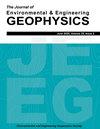基于有限-无限单元耦合法的渗流自势三维正演模拟
IF 0.7
4区 工程技术
Q4 ENGINEERING, GEOLOGICAL
引用次数: 8
摘要
多孔介质中的流势是自势的主要组成部分之一。它在环境地球物理学和工程地球物理学中引起了特别的关注。流电位正演模拟可以为相应的数据反演和解释奠定基础,提高自电位法的应用效果。传统有限元法细分面积大,计算量大,人工边界条件不适合复杂模型。引入Helmholtz-Smoluchowski方程来计算流势。为了减小细分尺度,提高计算效率和精度,提出了多向映射无限元的三种新的形状函数,并推导了有限-无限元耦合方法。通过一个均匀半空间的电阻模型验证了该方法的正确性和有效性。此外,采用改进的耦合方法对具有复杂地形的渗流模型和具有动态泄漏的填埋场模型进行了建模。结果表明,改进的耦合方法的精度优于未改进的耦合方法,并优于有限元法。该方法对复杂模型具有较好的适应性,适用于动态多源渗流模型的精确模拟。本文章由计算机程序翻译,如有差异,请以英文原文为准。
3D Forward Modeling of Seepage Self-potential Using Finite-infinite Element Coupling Method
The streaming potential in porous media is one of the main constituents of the self-potential. It has attracted special attention in environmental and engineering geophysics. Forward modeling of streaming potentials could be the foundation of corresponding data inversion and interpretation, and improving the application effect of the self-potential method. The traditional finite element method has a large subdivision area and computational quantity, and the artificial boundary condition is not suitable for complex models. The Helmholtz-Smoluchowski equation is introduced for evaluating the streaming potential. Then three new shape functions of the multidirectional mapping infinite elements are proposed and the finite-infinite element coupling method is deduced for reducing the subdivision scale and improving both the calculation efficiency and accuracy. The correctness and validity of the new coupled method are verified by a resistive model in homogeneous half-space. Besides, a seepage model with complex terrain and a landfill model with dynamic leakages are modeled using the improved coupled method. The results show that the accuracy of the improved coupled method is superior to the unimproved coupled method, and is better than the finite element method. Also, the coupled method has better adaptability to complex models and is suitable for the accurate simulation of dynamic multi-source seepage models.
求助全文
通过发布文献求助,成功后即可免费获取论文全文。
去求助
来源期刊

Journal of Environmental and Engineering Geophysics
地学-地球化学与地球物理
CiteScore
2.70
自引率
0.00%
发文量
13
审稿时长
6 months
期刊介绍:
The JEEG (ISSN 1083-1363) is the peer-reviewed journal of the Environmental and Engineering Geophysical Society (EEGS). JEEG welcomes manuscripts on new developments in near-surface geophysics applied to environmental, engineering, and mining issues, as well as novel near-surface geophysics case histories and descriptions of new hardware aimed at the near-surface geophysics community.
 求助内容:
求助内容: 应助结果提醒方式:
应助结果提醒方式:


